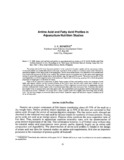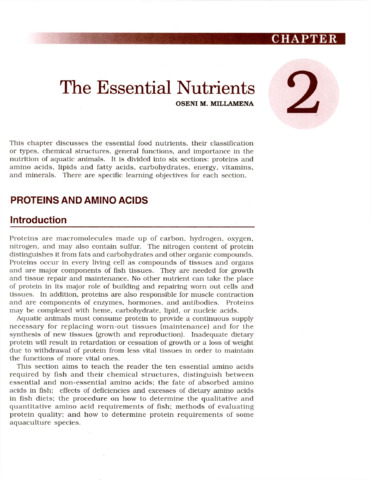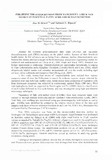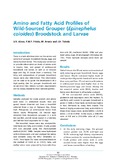Amino acid and fatty acid profiles in aquaculture nutrition studies
Share
Abstract
The amino acid profile is an important parameter in the evaluation of protein quality and in requirement studies. Amino acid profiles are usually determined in 2 steps: hydrolysis of the protein to constituent amino acids followed by quantitative analysis of the amino acids in the hydrolysate. The 10 amino acids known to be essential in most animals have been found to be essential in all fish so far studied. The reference amino acid profiles used in the amino acid requirement studies of various fish species include that of whole chicken, egg, fish egg and fish muscle. The amino acid profile of fish muscle provides a useful first approximation of the amino acid requirement of the young, growing fish in which the greatest proportion of weight gain is in the form of muscle.
Suggested Citation
Benitez, L. V. (1989). Amino acid and fatty acid profiles in aquaculture nutrition studies. In S.S. De Silva (Ed.) Fish Nutrition Research in Asia: Proceedings of the Third Asian Fish Nutrition Network Meeting (pp. 23-35). Manila, Philippines: Asian Fisheries Society.
Subject
Collections
Related items
Showing items related by title, author, creator and subject.
-
The essential nutrients: Proteins and amino acids
Millamena, Oseni M. (Aquaculture Department, Southeast Asian Fisheries Development Center, 2002)This section aims to teach the reader the ten essential amino acids required by fish and their chemical structures, distinguish between essential and non-essential amino acids; the fate of absorbed amino acids in fish; ... -
Philippine thraustochytrids from mangroves: A rich new source of essential fatty acids for human nutrition
Oclarit, Jose M.; Hepowit, Nathaniel L. (Marine Science Institute, University of the Philippines, 2007) -
Amino and fatty acid profiles of wild-sourced grouper (Epinephelus coioides) broodstock and larvae
Alava, Veronica R.; Priolo, Flora Mae P.; Toledo, Joebert D.; Rodriguez, Jesus C., Jr.; Quinitio, Gerald F.; Sa-an, Analyn C.; de la Peña, Milagros R.; Caturao, Romeo D. (Australian Centre for International Agricultural Research, 2004)This study was undertaken to provide information on the levels of amino acids in the muscle, liver and gonad of wild-sourced broodstock and larvae, as well as in neurula eggs and day 35 larvae from a hatchery. The fatty ...





